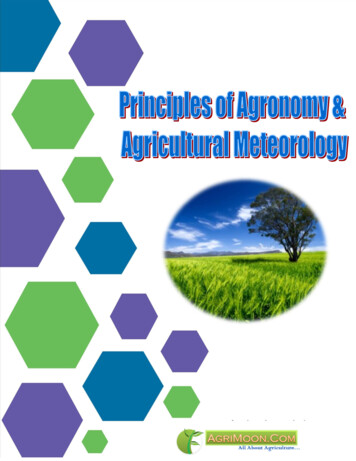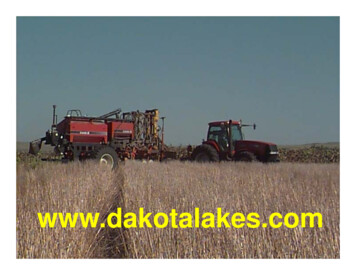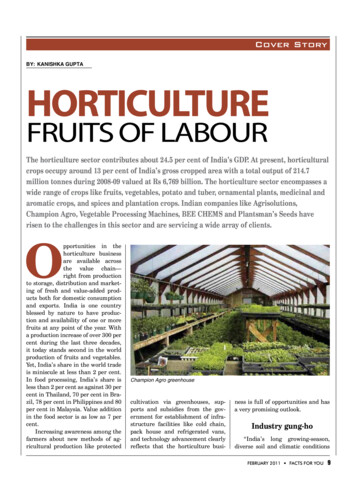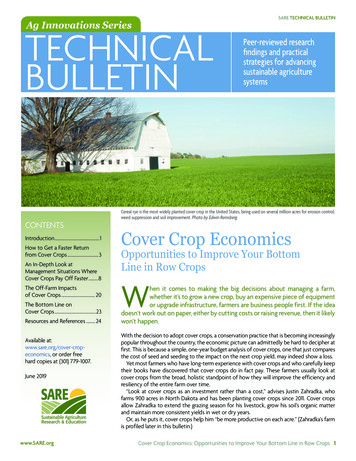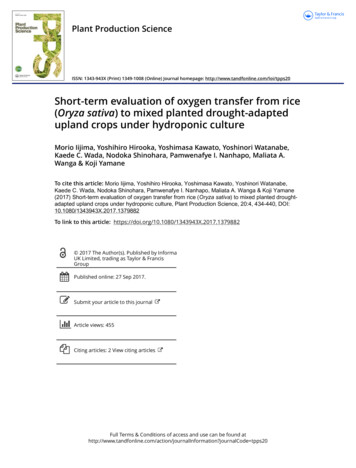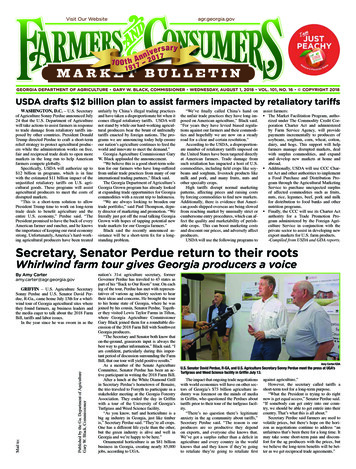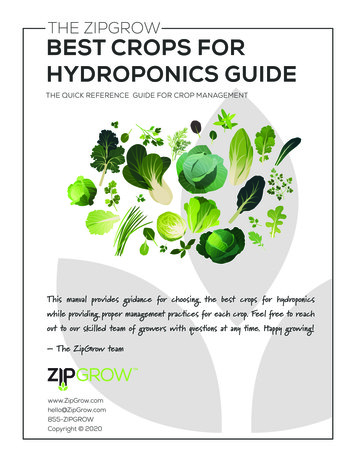
Transcription
THE ZIPGROWBEST CROPS FORHYDROPONICS GUIDETHE QUICK REFERENCE GUIDE FOR CROP MANAGEMENTThis manual provides guidance for choosing the best crops for hydroponicswhile providing proper management practices for each crop. Feel free to reachout to our skilled team of growers with questions at any time. Happy growing!– The ZipGrow yright 2020
Table Of ContentsOVERVIEWthe purpose of this guide.3differences between crops.3-4glossary.4GREENSarugula.6bok choy.7kale.8lettuce.9mustard greens.10swiss mint.17oregano.18parsley. 19rosemary. 20FRUITING CROPSstrawberries.22CONCLUSIONappendix a.23about ZipGrow.24
OverviewPurpose Of This GuideThe advent of hydroponics has changed the shape of growingpractices and operations of all shapes and sizes. Hydroponictechniques often require different crop conditions, and whenconditions are different, management is different.This guide is written to help you optimize growing conditionsand practices to grow crops better than ever before. Anyoneusing this manual, novice or expert, will be able reference thisas they grow any of the crops provided.Use this guide to build a crop list that will fit your growingexperience, compare the ideal pH and EC ranges for specificcrops, imagine the labor involved in planting and harvesting,and understand more generally what crops need to growoptimally.Differences Between CropsEnvironmental NeedsGrowers benefit from new technology and resources by being able to grow almost anythinganywhere. All they need to do is choose crops that can grow together in the environmentthey choose.There are some tricks for growing dissimilar crops in the same environment. For example,differences in irrigation needs can be solved by plumbing your system with valves on eachsection to control irrigation, timing, and pressure for independent sections. A grower withrosemary in one section can turn the valve onto that sector for a few hours a day, but stillwater fennel or lettuce on a constant drip by controlling the valves on those crops’ respectivesections.Reproductive CyclesThe reproductive stage of a plant’s life cycle is cued by age and environmental values likeheat and light. You can steer your crops to or away from these life cycles by pruning, and/orby adjusting light ratios, nutrient ratios, and temperature.For most greens and herbs, reproductive growth means bolting. During this stage, vegetativegrowth slows down and the leaves become bitter and tough.For other crops such as strawberries, cucumbers, squash, melons, etc., reproductive growthis the desired outcome so the plant bears fruit.3
Harvesting & PruningDiffering crop varieties and techniques require different harvestingmethods. Some crops (like lettuce) are only harvested once beforebeing torn out and replanted. Other crops, such as kale, mustard,chives, chard, and some herbs can be harvested multiple times.Harvest and prune carefully to maximize thenext production cycle of the plant.GlossaryApical growth: growth which grows upward from the apical bud of the plant; usually resultsin the “main” branch of the plant.Bolting: a shift from vegetative to reproductive growth, usually resulting in a tall inedibleflower stalk and a bitter taste.Cole crops: (Brassicas) varieties of the species Brassica oleracea, including mustard, cabbage, kale,broccoli, and kohlrabi, among others.EC: Electrical Conductivity (measure of dissolved nutrients in solution)IPM: (Integrated Pest Management) a pest management strategy which utilizes multiple types ofcontrol and precise timing to control pest populations for the best economic outcome in the longterm.Lateral buds: the set of undeveloped buds situated on the side of the stem of a plant which grow ifthe apical branch is badly damaged or removed.PPM: Parts Per Million (measure of dissolved nutrients in solution)Turn: the time it takes for a plant to grow from transplant to harvestable crops.**A note on conductivity measurements: PPM readings may differ from instrument toinstrument. The PPM levels provided in this guide are based on the ppm 500/ TDS standard(also known as the Hanna standard used by most North American-based meters). Whenin doubt, refer to EC over PPM as the unit. Click here for more information on the differentmeasurements of conductivity and here for our recommended conversion chart.4
GreensWhat You Should KnowThe leafy greens we know from our supermarket visits are limited in their variety, flavor, andoverall excitement. Luckily, there’s a whole world of crops that fall in this broad category thatre-excite both the eyes and the palate. By sourcing heirloom seeds you can expand what youknow and challenge what you thought was possible with the most mundane of crops. Evenif you decide to stick to highly traditional crops, growing and eating them fresh will be sure tochange your perceptions of how that crop should taste.The crops that fall into this category are typically very easy to grow and are much lowermaintenance than some varieties of herbs making them great for beginners or producerswho want less time growing and more time enjoying the fruits of their labors.For commercial growers, greens are considered low-dollar crops, fetching 3.50- 5.00per pound of produce. Though they bring in less monetarily per pound than most herbs,greens can be a benefit to farmers because they satisfy a specific and consistent need inmost communities. Greens can also be a liability-reducer for farmers. Knowing that it willonly take four to six weeks (a typical turn for greens) to return to full production is peace ofmind for those just getting started should issues arise causing an operation to shut down formaintenance or management.5
ArugulaAbout ArugulaArugula is a brassica, like mustard or kale. It carriesa spicy punch in a tender leaf, making it a greataddition to salads, pizzas, and sandwiches.Some varieties are spicier than others, with theRocket variety being considered the spiciest ofthe three most popular (Astro,Rocket, and Sylvetta).Though arugula grows like lettuce (some varieties are ready for harvest in just 3 weeks) andis in the family of brassicas, it’s often considered an herb.Growing ArugulaPlantingGerminate from seedpH range5.5-6.5HarvestingFull harvestEC/PPM0.8-1.4 / 400-700Yield5-7oz / Foot of Tower / HarvestLight hours12-18Pests and diseasesRare; most common are aphids and flea beetles.Disease problems rarely occur.TemperatureRange: 50–75 FIdeal: 65 FGermination3-7 DaysSeedlingTransplant14-21 Days1st Harvest4-5 Weeks2nd Harvest1-2 Weeks6-8 Weeks6
Bok ChoyAbout Bok ChoyBok Choy—also called white Chinese cabbage, Chinese Chard,Chinese Mustard Cabbage, Pak Choi, among others— belongs to theleafy vegetable pak choi family of Chinese brassicas. Bok Choyhas white or green, thick, crunchy stems with light to dark greenwide leaves.All parts, stems and leaves, can be eaten with the leavesbeing soft and buttery while the stalks are crunchy andslightly bitter.Size can vary from 4-12 inches tall, bigger if lengthier grow-outtimes are practiced.Growing Bok ChoyPlantingGerminate from seedpH range5.5-6.5HarvestingFull harvestEC/PPM1.5-2.5 / 750-1250Yield0.7-0.9lbs / Foot of Tower / HarvestLight hours14-18Pests and diseasesRare; most common are aphids andpowdery mildewTemperatureRange: 55–75 FIdeal: 65 FGerminationSeedling3-7 DaysTransplant14-21 DaysHarvest5-6 Weeks7-9 Weeks7
KaleAbout KaleKale has been hailed as a super food and has foundits way into home and restaurant menus alike. Cropvarieties from the scaly-looking Dinosaur Kale (alsocalled Tuscan Kale) and Curly Kale grace our soups,smoothies, salads, and more. Some varieties displayshades of red and purple, like Russian Red Kale.Kale’s wide electrical conductivity (EC) range makes it compatiblewith many different herbs and greens. Fortunately, kale is another cropwhich — when grown indoors — is targeted by only a few pests such as aphids and somepowdery mildew.Growing KalePlantingGerminate from seedpH range5.5-6.5HarvestingFor partial harvest, only take 30% of the plantat one timeEC/PPM1.6 to 2.5 / 800-1250Light hours14-18Yield0.5-0.7lbs / Foot of Tower / HarvestTemperatureRange: 45–85 FIdeal: 65 FPests and diseasesRare; aphids and powdery mildew mostlikely indoorsGerminationSeedling3-7 DaysTransplant14-21 DaysHarvest5-6 Weeks6-8 Weeks8
LettuceAbout LettuceLettuce is one of the most popular crops in the world. The coolweather crop grows sweet and tender, a perfect addition toany fresh dish.Lettuce grows well in almost any gardening system, whetherhydroponic, aquaponic, or traditional soil gardens. It takes uprelatively little space, has a short (5-6 weeks from transplantor 9-11 weeks from seed) growing cycle when it’s healthy, andthere is always high market demand.Hundreds of lettuce varieties are grown around the world. The common varieties, like redand green Romaines, Iceberg, Oak Leafs, Green Leaf, and Mesclun mixes, can be found inalmost any grocery store.Don’t forget about unique heirloom varieties. Seed companies like Baker Creek HeirloomSeeds offer great varieties of lettuce like Deer Tongue, Bronze Beauty, Brune D’Hiver,Cimmaron, and Devil’s Ear.Growing LettucePlantingGerminate from seedpH range5.5-6.5HarvestingHarvest lettuce as a whole head (or whole plant)and store at 32-35 F. Keep temperatures asconsistent as possibleEC/PPM1.0-1.6 / 500-800Light hours14-18Yield0.7-1.0lbs / Foot of Tower / HarvestTemperatureRange: 45–75 FIdeal: 65 FPests and diseasesAphids, leaf miners, and powdery mildewGerminationSeedling1-7 DaysTransplant10-14 Days6-8 WeeksHarvest4-5 Weeks9
Mustard GreensAbout Mustard GreensBrassica juncea, or mustard greens, is another member of thebrassicas family (a relative of kale and cabbage). Although itsprecise origins are unknown, there’s support to assume thatmustard is native to Eastern Europe and Asia, as is reflectedby its common names – India mustard and China mustard.The ruffled leaves of mustard taste similar to radishes and can adda spicy bite to a salad, sandwich, or can be eaten by themselves (oftensteamed). Mustard is often cultivated for its seed, which is used in brown mustard (thecondiment) and has been used for centuries in folk remedies for aches, arthritis, and even topromote cow milk production in some areas of the world.A grower favorite is the Southern Giant Curled variety; however many varieties have beenbred with different flavors and colors ranging from green to dark purple.Growing Mustard GreensPlantingGerminate from seedpH range5.5-6.5HarvestingFor partial harvest, only take 30% of the plantat one timeEC/PPM1.2 to 2.4 / 600-1200Yield0.5-0.7lbs / Foot of Tower / HarvestLight hours14-18Pests and diseasesPotential pests and diseases are minimal; cabbageloopers, flea beetles, cabbage worms, and clubrootTemperatureRange: 50–75 FIdeal: 65 FGerminationSeedling3-7 DaysTransplant14-21 Days6-8 WeeksHarvest4-5 Weeks10
Swiss ChardAbout ChardChard is a French green popular in greenhouses and kitchensaround the world. The tender leaves add freshness and a mildbuttery flavor to dishes like soup, the bacon-friendly southerndish “greens and beans”, and even in salads or on BCG (beet,chard, and goat cheese) sandwiches.Chard leaves grow on elegant stems which range in colorfrom red, to yellow, to white, and can get larger than a dinnerplate. Chard is a great crop for beginners due to it’s easy-togrow nature.The cool weather crop is not only tasty and easy to cook, but easyto grow in almost any hydroponic or aquaponic system. A multitude ofvarieties can be found from seed companies; our favorite is Swiss “Rainbow”Chard. Chard is bi-annual, so it will not bolt for the first year which makes it agood candidate for cut-and-regrow practices.Growing ChardPlantingGerminate from seedpH range5.5-6.5HarvestingOnly harvest 30-35% of the plant, leaving the restof the plant to support another harvestEC/PPM1.6 to 2.3 / 800-1150Light hours14-18Yield0.5-0.7lbs / Foot of Tower / HarvestPests and diseasesPotential pests and diseases are minimal; very rarelywill aphids & powdery mildew effect chardGerminationSeedling4-10 DaysTemperatureRange: 55–75 F and cold hardyIdeal: 65 FTransplant14-21 Days6-8 WeeksHarvest3.5-4 Weeks11
HerbsWhat You Should KnowHerbs are some of our favorite crops to grow due to the outstanding flavor and aromasthey pack into their typically small form factors. While these crops typically take longer toreach maturity, these crops will be sure to turn heads wether you’re growing them for yourfriends and family or as a commercial producer. Much like everything else grown locally andwith purpose, the qualities these herbs will possess are sure to blow away all preconceivednotions of what they have to offer.For commercial growers, herbs are typically high-value crops regularly bringing in 1.99/oz.- 2.99/oz and more depending on the market. Most herb varieties are also capable ofcontinuous yield making them an excellent choice should your market support them. Whilesome herbs can be easier to grow than greens, the longer maturation time can causeproblems in the event something in the operation goes wrong. It takes longer for a grower toreach full production again after an incident, however, most herbs can be harvested multipletimes.12
BasilAbout BasilThere are dozens of basil varieties, from spicy bush basil,to lemon basil, to Thai basil, all of which bring a delightfultwist to any dish when paired well. Favorites are theclassic sweet basil, Genovese basil, and dwarf basil. Thiswildly variable crop produces large harvests and is sofragrant and delicious you won’t want to stop growing itonce you start.Growing BasilPlantingGerminate from seed or start from clonepH range5.5-6.5HarvestingPrune apical meristem to cue lateral growthEC/PPM1.6-2.2 / 800-1100Yield7-10oz / Foot of Tower / HarvestLight hours14-18Pests and diseasesPotential threatening pests include nematodes, aphids,thrips, flea beetles, whiteflies, snails, and slugs. Diseasesinclude damping off, root rot, leaf spot diseases, fusariumwilt, and downy mildewTemperatureRange: 65–90 FIdeal: 75 FGermination5-7 DaysSeedlingTransplant3-4 Weeks1st Harvest3-4 Weeks2nd Harvest2-3 Weeks7-9 Weeks13
ChivesAbout ChivesCommon chives are the variety most used.A few other varieties, like garlic chives andChinese chives are also available.Chives are a tough crop that will survive a widerange of temperatures and can evengo without water for a while without it impacting quality. Chives are also fairlypest-resistant, rarely infected with diseases, and rarely are targeted by insect pests.Chives propagate rapidly from roots, and can be planted by division (this is ideal since germinationtimes on chives are relatively long). Growers using ZipGrow Towers can simply tear apart the rootsof a plant from another ZipGrow Tower and use it to plant multiple others.Rarely will growers need to use seeds to grow chive seedlings as using rootstock is the fastest andmost effective way to grow them.Growing ChivesPlantingGerminate from seed or from root by breakingapart mature plants and re-plantingpH range5.5-6.5EC/PPM1.6-2.2 / 800-1100HarvestingHarvest every 2-3 weeks by cutting the plant to1-2 inches from the crownLight hours14-18Yield7-8oz / Foot of Tower / HarvestPests and diseasesRare; most common in hydroponic systems are virusesand fungus gnatsGerminationSeedling2-3 WeeksTransplant4-6 Weeks10-12 WeeksTemperatureRange: 55–80 FIdeal: 70 F1st Harvest6-9 Weeks2nd Harvest2-3 Weeks14
CilantroAbout CilantroCilantro can be a tricky crop to grow since it boltsvery easily, especially in hot conditions. If bolting istriggered, trim the bolts and adjust environmentalconditions. Be aware that the flavor of the greensbecomes more bitter and harsh once the plant hasbolted. Growers can purchase slow bolting seeds tominimize the potential for crop failure.Growing CilantroPlantingGerminate from seedpH range5.5-6.5HarvestingHarvest completely cutting at the base of the plantand on the face of the towerEC/PPM1.2 -2.0 / 600-1000Light hours14-18Yield5-7oz / Foot of Tower / HarvestTemperatureRange: 50–80 FIdeal: 65 FPests and diseasesPests include fungal wilt, leafhoppers, and aphids;Diseases include powdery mildewGermination5-10 DaysSeedlingTransplant3-4 Weeks1st Harvest3-4 Weeks2nd Harvest2-3 Weeks7-9 Weeks15
FennelAbout FennelA mildly sweet herb with a taste reminiscent of anise, fennel is edibleboth as bulbs and greens. The greens may be harvested once beforea full-plant harvest a few weeks later.Fennel prefers a lower EC and moderate pH. Thoughfennel often proves drought tolerant, heat tolerant,and cold tolerant, it is not frost tolerant. Fennel rarelystruggles with pests if it’s kept healthy, althoughaphid infestations could affect the crop.Fennel has a wider range of germination rates, from about 60% to 90%. Be sure to get goodseeds (Baker Creek and Johnny Seeds are both great places to start). Seeds take 1-2 weeksto germinate and are typically ready to plant 3-5 weeks later. The bulbs can be harvested assoon as the grower wants, but .5 to 1lb bulbs are standard at most markets. From seedlingsit takes most plants 6-8 weeks to reach harvesting size.Growing FennelPlantingGerminate from seedpH range5.5-6.5HarvestingAt first harvest, only take 30% of the greens,take the full plant on the second harvestEC/PPM1.0-1.8 / 500-900Light hours14-18Yield8-10oz / Foot of Tower / HarvestTemperatureRange: 55–75 FIdeal: 65 FPests and diseasesRare; aphids and damping off are most commonGermination7-10 DaysSeedlingTransplant3-4 Weeks1st Harvest3-4 WeeksBulb Harvest2-4 Weeks7-10 Weeks16
MintAbout MintThere are dozens of types of mint, but the main varieties arespearmint (Mentha spicata), peppermint (Mentha x piperita),and pennyroyal mint (Mentha pulegium). Some of the othermints like lemon mint (Monarda citriodora) are actually notmint at all. When mint is used in the kitchen, it’s usually spearmint.Mint can be grown from seed, but using cuttings or rootstock ismuch quicker, especially on a commercial scale. From mint cuttings,or “clones”, mint roots out and grows to maturity within a few weeks.For stem cuttings, you can select healthy green sprigs and simply set themin water. We’ve also used cotton or loose soil to set cuttings.For rootstock, you can pull out the media when a mature tower becomes overgrown, removesome root material to populate a new tower, and simply tuck the root material in the newmedia. Then replant both towers — one with old and one with new root material — and voila!Growing MintPlantingGerminate from seed, or start fromcutting, or rootstockpH range5.5-6.5EC/PPM1.6-2.6 / 800-1300HarvestingMultiple harvests through pruning, the last ofwhich the entire crop is harvested completelyLight hours14-18Yield8-10oz / Foot of Tower / HarvestTemperatureRange: 55–75 FIdeal: 70 FPests and diseasesOccasional verticillum wilt and powdery mildewGerminationSeedling10-15 DaysTransplant2-3 Weeks8-10 Weeks1st Harvest5-8 Weeks2nd Harvest2-3 Weeks17
OreganoAbout OreganoOregano (Origanum spp.) is a small, bushy herb with astrong unique flavor that’s especially pungent whenthe herb is fresh. The leaves are used fresh and driedin most types of cuisine, but especially Italian andFrench.There are three main kinds of oregano used for culinary purposes:Greek (Origanum vulgare hirtum), Mexican (Lippia graveolens, whichactually isn’t oregano at all), and Italian (Origanum x majoricum).Oregano has small, rounded leaves that are fuzzy in some species – this makes it harder forthem to deal with high humidity.Growing OreganoPlantingGerminating from seed works, propagation bycutting is bestpH range5.5-6.5EC/PPM1.5-2.0 / 750-1000HarvestingMultiple harvests through pruning, the last ofwhich the entire crop is harvested completelyLight hours14-18Yield6-7oz / Foot of Tower / HarvestTemperatureRange: 55–80 FIdeal: 70 FPests and diseasesPests included; thrips, whiteflies, aphids, spidermites, and leaf miners. Diseases affecting oreganoplants are primarily caused by fungiGermination7-14 DaysSeedlingTransplant4-5 Weeks1st Harvest3-4 Weeks2nd Harvest2-3 Weeks7-9 Weeks18
ParsleyAbout ParsleyParsley is a Mediterranean native used worldwide both as agarnish and as a popular addition to savory dishes. Severalvarieties of parsley exist, from the more bitter and frillygarnish parsley to the flavorful, tender large leaf varieties.Though popular mostly as a cooking ingredient, parsleyhas been used in a variety of ways, from a medicinalingredient to a symbol in ceremonies like the Seder dinner.Parsley’s tolerance of a wide temperature range and EC rangemake it an easy crop for farmers to add into a crop set. Large leaf varieties like Italian flat leafgrow abundantly in hydroponics (or aquaponics), and farmers using ZipGrow Towers shouldplan on harvesting a lot of weight from the large plants, which grow 12-18 inches from theface of the Tower or media.Growing ParsleyPlantingGerminate from seedpH range5.5-6.5HarvestingMultiple harvests—it’s common to harvestparsley twice before replantingEC/PPM1.4 -2.4 / 700-1200Light hours14-18Yield8-10oz / Foot of Tower / HarvestTemperatureRange: 55–80 F and cold hardyIdeal: 70 FPests and diseasesPests and diseases are rare, the most commonpests are thrips and aphidsGerminationSeedling2-3 WeeksTransplant3-4 Weeks1st Harvest5-8 Weeks2nd Harvest2-3 Weeks10-11 Weeks19
RosemaryAbout RosemaryRosmarinus officinalis belongs to the family Lamiaceaelike many of our culinary herbs. Rosemary is a great fit forindoor farming because it can be very compact.Like its co-members of Lamiaceae, lavender andthyme, rosemary prefers “dry feet”. This means thatgrowers should give roots a dry period betweenwatering.Starting rosemary from seed can be a finicky process – the seeds need consistent moistureand germination rates tend to be around 30-50%. Growers are often better off propagatingthe plants from cuttings, although some argue that best flavors and aromatics come fromseedgrown plants.Growing RosemarypH range5.5-6.5PlantingGerminating from seed is very difficult,propagation from clone is fastest and easiestEC/PPM1.2-1.8 / 600-900HarvestingMultiple harvests are common through pruningLight hours14-18Yield0.8-1.1 oz / Foot of Tower / HarvestTemperatureRange: 60–80 F and cold hardyIdeal: 75 FPests and diseasesPests and diseases are rare, the most common arebotrytis and powdery mildew when over-wateredGerminationSeedling2-3 WeeksTransplant3-4 Weeks1st Harvest6-9 Weeks2nd Harvest2-3 Weeks10-12 Weeks20
Fruiting CropsWhat You Should KnowFrom a grower’s perpective, fruiting crops are very unique. They require a very specific setof light and nutrient mixes throughout the course of their lifecycles, the growing periods aremuch longer, and they generally require noticably more skill and labor to grow. Luckily, itsfor these reasons that when done correctly, adding fruiting crops to your crop list can be sogratifying. Not only that, but depending on where you live, access to fresh fruits and veggiescan be extremely limited making a fresh product that much more noticeable and enjoyable.To grow fruiting crops well requires more information than what we can provide in this shortguide. However, be sure to research both light and nutrient cycles for vegging and fruitingstages, in addition to proper long-term pest management. Since fruiting crops have toproduce both vegetative and reproductive growth, nutrient requirements are much higherparticularly in the fruiting stages of the crop’s lifecycle and it’s for this reason that nutrientlevels in a system with fruiting crops require more active management than systems withgreens or herbs.We have only included strawberries in this guide as it is the easiest fruiting crop to grow inour ZipGrow Towers and we do not recommend growing large-statured crops (like tomatoes)in our Towers. But should you choose to grow larger-bodies and/or vining crops, know thatthese plants may require trellising which may be done with string, wood, netting, or wire. Alsonote that the large plants may make your towers bulkier and more awkward to move.21
StrawberriesAbout StrawberriesGrowers can order strawberries from most big seed companies like Burpee’sor Johnny’s Seeds with dozens of varieties available. The twomain types of strawberries are ever-bearing and junebearing—werecommend ever-bearing (or “day-neutral”) varieties.Strawberries are best grown from rootstock rather thanseed. Vegetative growth (runners) tends to be much fasterthan sexual reproduction (seeds), so you can cut the time fromplanting to production by months or years by using rootstock.Strawberries are prone to pest and diseases. Use miticides to managemites, and a fungicidal dunk before planting to prevent fungal infections.**Remember: pesticides can be a useful tool for growing long grow-cycle crops, like fruitingcrops. Should you choose to use chemical pesticides ALWAYS read the label before usingyour chosen pesticide. It is a legal document, straying from instructions is unlawful forcommercial producers!Growing StrawberriesPlantingGerminating from seed is very difficult,propagation from clone is fastest and easiestpH range5.5-6.5EC/PPM0.8-1.4 / 400-700HarvestingMultiple harvests are common through pruningLight hours14-18Yield1.2-1.8 oz / Foot of Tower / TurnTemperatureRange: 65–75 FIdeal: 70 FPests and diseasesPests and diseases of strawberries includearachnids like spider mites, pythium, rhizoctonia,and other fungal pathogensRoot Stock1st Harvest7-10 Weeks2nd Harvest1 Week3rd Harvest1 Week22
ConclusionAppendix ACool Region Crops Lettuce Arugula Kale Mustard Greens Bok Choy Mint Cilantro (Coriander) Tarragon Fennel Nasturtiums PeppermintWarm Region Crops Bok Choy Oregano Basil Lemongrass SpearmintLow Water Crops Cilantro Sage Chives Oregano Tarragon Fennel Nasturtiums PeppermintCrops For Beginners Lettuce Bok Choy Mustard Greens Chard Kale Mint Arugula Chives Fennel23
About ZipGrowThe Purpose Behind What We DoOur VisionZipGrow’s vision of a better future looks like: aglobal attitude of people wanting to participateand contribute—and have equal access—to thehighest quality, environmentally and economicallysustainable produce possible.Our MissionZipGrow’s mission is to design and manufacturethe most economically viable, resource-efficient,and productive hydroponic equipment possible forpeople who believe in smarter, local food sourcesand want to participate in changing how peoplethink about and access food.Thank You!Whether you’re a farmer, hobbyist, or anything between, by reading this document you’re takingsteps towards being part of a better food system and for that we are truly grateful. We alsorealize that there are many great resources out there that are at your disposal and we wantto thank you for using us as a tool to help you be more effective in your pursuit for local andsustainable food.We hope this guide has been useful to you and if you have any feedback we would love to hearfrom you! We believe that the success of local and urban farmers is the success of the foodsystem, so we make it our mission to help new farmers and growers everywhere see successin their efforts. If you can’t be successful then neither can we so if you have additional needs orquestions outside the scope of this manual, please contact right 202024
Lettuce grows well in almost any gardening system, whether hydroponic, aquaponic, or traditional soil gardens. It takes up relatively little space, has a short (5-6 weeks from transplant or 9-11 weeks from seed) growing cycle when it’s healthy, and there is always high market demand.
